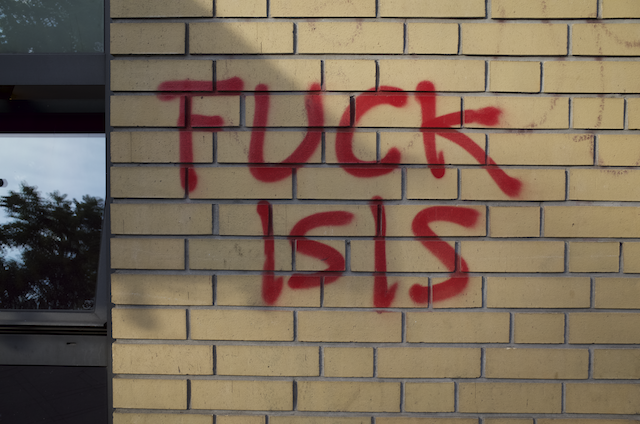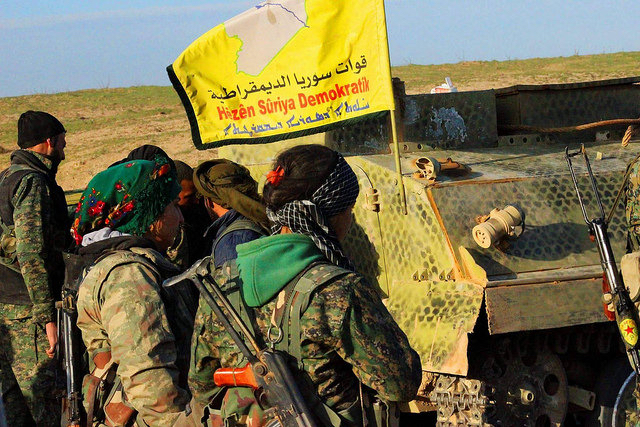Why ISIS as the standard-bearer of Sunni resistance? It is not the result of some lusting for barbarism on the part of the region’s Sunnis. It is not even because of the fearsome barbarity with which the Islamic State enforces its edicts (although that helps). Nor is it because its military and security structures are designed and run on Baathist lines (though that helps too).
The reason ISIS is so successful is the result of three factors. First, ISIS draws strength from the sense of encirclement of the Fertile Crescent’s Sunnis. In the east, they are being battered by Baghdad’s Shia government and its militia, themselves guilty of war crimes including massacres. In the West, they are being barrel-bombed by the Alawite power in Damascus, which is largely responsible for the state Syria is now in. In the north, they’re being pressured by the Kurds.
Second is a strategy developed and pursued by Bashar el-Assad that was being discussed in foreign-policy circles as far back as 2012. It is devastatingly effective in its simplicity: it consisted of the Syrian army pounding every rebel group except the most extreme ones, in order to nurture those best able to conform to a state caricatures of a brutal enemy. This would position Assad as the only bulwark between civilization and barbarism, and allow him to push demands for his departure to the background. The groups spared morphed and merged into what is now ISIS. This strategy, buttressed by Iranian strategists, Hezbollah fighters and Russian weaponry, led to today’s Syrian map: a Western third of government-controlled territory, where most of Syria’s non-Sunni population resides, a contested cordon where Russia and the Syrian government rare degrading other opposition groups, and the Islamic State.
That plan is playing out to perfection. Bashar al-Assad’s survival is now grudgingly being accepted by Western chancelleries (“temporarily”, of course), despite the blood on his hands. Assad controls most of the best agricultural land in Syria, and most of its remaining population, cleansed of most Sunnis. The “moderate” rebels who could really threaten him in the court of public opinion are reduced to a few tattered bands. And a Sunni dictatorship, clad in Takfiri garb, helpfully draws the world’s ire.
The third factor is intrinsic to what ISIS actually is. Far from being a band of bloodthirsty utopians, it is a carefully engineered machine for taking over and controlling populations designed by people from Saddam Hussein ‘s Mukhabarat. They have re-created the kind of dictatorship familiar to Arabists from other Baathist regimes (much of the ISIS leadership in Syria is Iraqi). Many were trained in the former Soviet Union, which helps explain ISIS’s set-up: four different secret services watching over one another; many cells working independently of one another in a mixture of paranoia, and a desperate willingness to please; a solid bureaucracy to run controlled territory and buy popular allegiance through the provision of justice, municipal and social services; all buttressed by the use of extreme violence to instill fear and loyalty. The emirs and walis of the Islamic State, its nomenklatura, are generously rewarded – but risk being suddenly removed and killed at any time.
If it does sound familiar, that’s because it is. It’s a classic Stalinist set-up, very similar to the one used by Soviet Communists to take over Baltic and Central European states between 1940 and 1949. The cultural differences are actually rather minor: the ideological dressings used – communism and Islamism – are in both cases used as tool to attract recruits and provide an ideological backbone, but do little more. As in 1950s Central Europe, when the scales fell from many convinced Communists’ eyes, most would-be jihadists moving to the Caliphate are rapidly disillusioned and are being kept in line through terror. The ones that drink the Kool-Aid become the Caliphates’ Spetznaz: they are the elite dispatched to carry out operations like Paris.

Understanding that the Caliphate is a surprisingly well-run mukhabarat state tolerated by Assad and the Iraq’s Shia-run government helps understand the difficulty it presents to a bloodied West. Take the Islamic State’s almost entirely Sunni population. Spread between Iraq and Syria, it is large, numbering roughly 24 million people. Why have they taken refugee under the black flag of Jihad? How can they be driven from the notion that the West seeks to subjugate them?
The opening that Sunni Iraqi generals exploited to create ISIS came from the pressure the Sunnis have been under ever since the American invasion of Iraq. These armies, all too easily painted as “crusader forces”, are the ones that drove Iraqi Sunnis from the power they enjoyed since the country’s independence. Subsequent American dealings with them, from Paul Bremer’s disbanding of the Iraqi Army and intelligence services in 2003, to the abandonment of Sunni allies gathered in the Tribal Awakening initiative after 2008, have been ham-fisted. Things did not get better after America’s withdrawal. Iraq’s Shia-led governments have systematically excluded Iraq’s Sunnis from power and sinecures. All this has generated a powerful sense of martyrdom among Sunnis there.
That’s why bombing ISIS is a bad idea. More “crusaders” bombing Sunnis fits right into that narrative of martyrdom. It’s also perfect gift to ISIS’s martial propaganda machine. Unlike the proud mujahireen who took the fight to godless Paris, the crusaders are so fearful for their lives that they refuse to fight, only raining death from above. Videos of crying mothers holding the dismembered bodies of their children are already circulating online, purporting to be from Raqqa. The outrage this generates among young Sunnis everywhere – including in the banlieues ringing France’s cities and in the Brussels suburb of Molenbeek – guarantees more trouble down the road.
Instead, avoiding feeding Sunni grievances must become a high strategic priority. We will have to work with them, in Europe, the Gulf and the Levant, to take the wind out of ISIS’ sails. That means recognizing that Sunnis have been abominably treated by the governments of Syria and Iraq; learning the numerous lessons from the extraordinary mishandling of Iraq’s American occupation; and thinking hard about a solution that respects the rights of all of the region’s numerous ethnoreligious groups.
The idea that multireligious states like Syria and Iraq could be induced to fairly manage the demands of their constituents is, alas, an early casualty of this analysis. The Baathists did manage to reduce the role of religious identities in their lands (Syria’s Baathists are mostly from the Shia-linked Alawite minority; Iraq’s from that country’s Sunni minority; both built up the idea of the proud, secular Arab to deal with their uncomfortable minority status), but they are now gone (Iraq) or drowning in blood (Syria).
The American intervention, by ignoring the importance of ethno-religious identities, brought these back with a vengeance in Iraq. Bashar El-Assad’s decision, early on in his country’s revolution, to focus ferocious force on Sunni rebel-held areas, did the same there. Your ethnic-denominational signifiers are now the most important things about you anywhere from the Mediterranean coast to the Iranian border.

That genie will be hard to put back in a bottle. Can anyone seriously imagine that Syria, which was 75% Sunni before the war, will one day accept to be run by a Sunni majority government that would by definition include ISIS-tainted officials? Does anyone imagine the Kurds, Yazidis, Turkmen, or Assyrians ever accepting such an outcome? Yet that is what democracy, should it ever be tried there, is likely to deliver. A moment’s thought shows that any solution that is predicated on the words “Syria”, “Iraq” and “democracy” appearing in the same sentence is utopian. This dream, long pursued by the US in Iraq, should not infect outside powers’ policies any longer.
Yet a solution to the regional mess is urgently needed, if only to reduce the flow of refugees fleeing the mayhem, or the risk of more ISIS spetznaz turning Western cities into fearful hives.
That solution has two major elements. First, dealing with the immediate threat to Western cities. There, little is needed beyond better police and intelligence work, especially in Europe; and securing external borders while maintaining an open-door policy to genuine refugees. Last week’s meeting of European interior ministers was a step in the right direction: sharing intel and databases across the Union is long overdue, as is creating a proper Schengen border force.
That will help us deal with a threat that, all things considered, remains minor. Out of the over 30,000 foreign fighters that are estimated to have gone to Syria, only about a dozen have so far managed to successfully carry out attacks back home, in the West.
Second, we need to accept that ISIS is right about one thing: Sykes-Picot is dead. Look at that map again. In the West, there is a rump Syria run by Assad that, shorn of its Sunni element, remains multiethnic. It includes Christians, Druze, Alawites and various smaller minorities and is supported by Iran and Russia. In the East, there is a Shia state centred on Baghdad and supported militarily and financially by Iran and the United States. In the North, there are autonomous Kurdish regions built on ethnic, not religious lines, supported by the United States and Europe, but under Turkish pressure. And in the South, there are the Sunni states of Jordan and especially Saudi Arabia, many of whose citizens and religious institutions support the Islamic State, the new entity at the region’s centre. Syria and Iraq, those artificial entities, are failed states.

Leaving them to rot guarantees trouble. They need to be formally buried and replaced by new entities based on the defacto borders drawn by the war. Recognizing and strengthening the new states that could be built behind them will go a long way to guarantee long-term stability. But in the short term, that leaves the question of what, exactly, to do with the Islamic State and the Sunni population it so expertly controls.
We can distinguish two options. The first is a full invasion designed to replace ISIS institutions and leaders with less extreme ones. That’s an extremely high-risk strategy for many reasons, starting with the paucity of potentially successful invaders. The US and its allies did not do a great job in Iraq. The Sunni coalition against Yemen’s Houthis is inept and brutal; and Turkish forces are distracted by their counterproductive campaign against the Kurds.
As for Iraq’s army, the less said the better. That leaves… the Russians. But after Georgia, Crimea and the Donbas, joining a Russia-led alliance will demand contortions that many NATO members will refuse to perform. For many, Mr Putin is a bigger long-term threat than the wastelands of Syria.
That leaves the second option: containment. An unspoken understanding could let ISIS be, provided it ceases overseas operations.
Before you give free rein to outrage, remember how well that worked during the Cold War. The Soviet Union was a dangerous, unjust, murderous regime. But eventually it collapsed under the weight of its own contradictions, without a single shot being fired.
One can imagine similar dynamics taking hold in an Islamic State shorn of external threats. Already, numerous reports indicate that its pull of new recruits is weakening and that the Syrians are chafing under what they see as the foreign occupation of ISIS jihadists drawn from many countries.
An ISIS surrounded by more stable non-Sunni states controlling clear border, shorn of its crusader invasion narrative, will eventually evolve – or revolutionize its way to – a less extreme form of governance. All we have to do is monitor its borders and trade – and wait. The rest is policing.
Keep calm and carry on is, indeed, the wisest advice in these troubled times.
Photographs courtesy of Joel Schalit.





